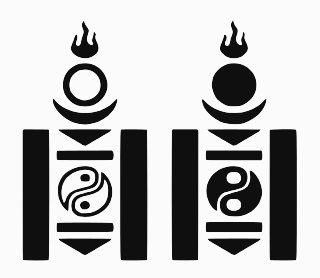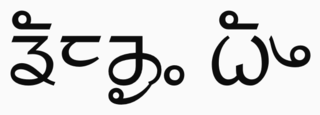
An abugida – sometimes also called alphasyllabary, neosyllabary, or pseudo-alphabet – is a segmental writing system in which consonant–vowel sequences are written as units; each unit is based on a consonant letter, and vowel notation is secondary, similar to a diacritical mark. This contrasts with a full alphabet, in which vowels have status equal to consonants, and with an abjad, in which vowel marking is absent, partial, or optional – in less formal contexts, all three types of the script may be termed "alphabets". The terms also contrast them with a syllabary, in which a single symbol denotes the combination of one consonant and one vowel.

The Brahmic scripts, also known as Indic scripts, are a family of abugida writing systems. They are used throughout the Indian subcontinent, Southeast Asia and parts of East Asia. They are descended from the Brahmi script of ancient India and are used by various languages in several language families in South, East and Southeast Asia: Indo-Aryan, Dravidian, Tibeto-Burman, Mongolic, Austroasiatic, Austronesian, and Tai. They were also the source of the dictionary order (gojūon) of Japanese kana.

The Soyombo script is an abugida developed by the monk and scholar Zanabazar in 1686 to write Mongolian. It can also be used to write Tibetan and Sanskrit.
The Odia script is a Brahmic script used to write primarily Odia language and others including Sanskrit and other regional languages. It is one of the official scripts of the Indian Republic. The script has developed over more than 1000 years from a variant of Siddhaṃ script which was used in Eastern India, where the characteristic top line transformed into a distinct round umbrella shape due to the influence of palm leaf manuscripts and also being influenced by the neighbouring scripts from the Western and Southern regions.

Surat Buhid is an abugida used to write the Buhid language. As a Brahmic script indigenous to the Philippines, it closely related to Baybayin and Hanunó'o. It is still used today by the Mangyans, found mainly on island of Mindoro, to write their language, Buhid, together with the Filipino latin script.

The Cham script is a Brahmic abugida used to write Cham, an Austronesian language spoken by some 245,000 Chams in Vietnam and Cambodia. It is written horizontally left to right, just like other Brahmic abugidas.
An inherent vowel is part of an abugida script. It is a vowel sound which is used with each unmarked or basic consonant symbol. For example, if the Latin alphabet used 'i' as an inherent vowel, "Wikipedia" could be rendered as "Wkpeda" [w(I)+k(I)+p+e+d(I)+a].

Limbu is a Sino-Tibetan language spoken by the Limbu people of Nepal and Northeastern India as well as expatriate communities in Bhutan. The Limbu refer to themselves as Yakthung and their language as Yakthungpan. Yakthungpan has four main dialects: Phedape, Chhathare, Tambarkhole and Panthare dialects.

Warang Citi is a writing system invented by Lako Bodra for the Ho language spoken in East India. It is used in primary and adult education and in various publications.

The Lepcha script, or Róng script, is an abugida used by the Lepcha people to write the Lepcha language. Unusually for an abugida, syllable-final consonants are written as diacritics.
In orthography, a zero consonant, silent initial, or null-onset letter is a consonant letter that does not correspond to a consonant sound, but is required when a word or syllable starts with a vowel. Some abjads, abugidas, and alphabets have zero consonants, generally because they have an orthographic rule that all syllables must begin with a consonant letter, whereas the language they transcribe allows syllables to start with a vowel. In a few cases, such as Pahawh Hmong below, the lack of a consonant letter represents a specific consonant sound, so the lack of a consonant sound requires a distinct letter to disambiguate.
Ga is the third consonant of Indic abugidas. In modern Indic scripts, ga is derived from the early "Ashoka" Brahmi letter , which is probably derived from the Aramaic letter after having gone through the Gupta letter .
Ja is the eighth consonant of Indic abugidas. In modern Indic scripts, ja is derived from the early "Ashoka" Brahmi letter after having gone through the Gupta letter .

Zanabazar's square script is a horizontal Mongolian square script, an abugida developed by the monk and scholar Zanabazar based on the Tibetan alphabet to write Mongolian. It can also be used to write Tibetan language and Sanskrit as a geometric typeface.
A is a vowel of Indic abugidas. In modern Indic scripts, A is derived from the early "Ashoka" Brahmi letter after having gone through the Gupta letter . Bare consonants without a modifying vowel sign have the "A" vowel inherently, and thus there is no modifier sign for "A" in Indic scripts.
U is a vowel of Indic abugidas. In modern Indic scripts, U is derived from the early "Ashoka" Brahmi letter after having gone through the Gupta letter . As an Indic vowel, U comes in two normally distinct forms: 1) as an independent letter, and 2) as a vowel sign for modifying a base consonant. Bare consonants without a modifying vowel sign have the inherent "A" vowel.
Ḷ or Vocalic L is a vowel symbol of Indic abugidas. In modern Indic scripts, Ḷ is derived from the Brahmi letter . As an Indic vowel, Ḷ comes in two normally distinct forms: 1) as an independent letter, and 2) as a sign for modifying a base consonant. Bare consonants without a modifying vowel sign have the inherent "A" vowel.
Ai is a vowel of Indic abugidas. In modern Indic scripts, Ai is derived from the early "Ashoka" Brahmi letter . As an Indic vowel, Ai comes in two normally distinct forms: 1) as an independent letter, and 2) as a vowel sign for modifying a base consonant. Bare consonants without a modifying vowel sign have the inherent "A" vowel.
O is a vowel of Indic abugidas. In modern Indic scripts, O is derived from the early "Ashoka" Brahmi letter after having gone through the Gupta letter . As an Indic vowel, O comes in two normally distinct forms: 1) as an independent letter, and 2) as a vowel sign for modifying a base consonant. Bare consonants without a modifying vowel sign have the inherent "A" vowel.

The Tai Viet script is a Brahmic script used by the Tai Dam people and various other Thai people in Vietnam and Thailand.










